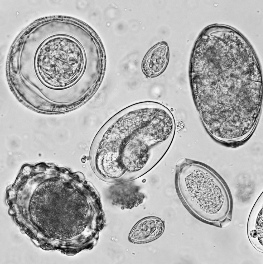

Brunel Microscopes Ltd
A specialist part of our web site that deals with the identification of worm eggs
Identify and count worm eggs in the droppings of cattle, mammals and birds

Brunel Microscopes Ltd, Unit 2 Vincients Road, Bumpers Farm Industrial Estate, Chippenham, Wiltshire SN14 6NQ
Tel: 01249 462655 Email: mail@brunelmicroscopes.co.uk
Most mammals, birds and reptiles have parasites that have the objective of inhabiting a host to complete their life cycle. Intestinal worms and flukes are widespread and can cause particular harm if not treated promptly. The diagnosis of their presence is made from identifying worm eggs in droppings with a microscope. This is not a laboratory only process and can be mastered quite easily by those with no previous experience in such matters on ‘the kitchen table’ as it were. The purpose of this web site is to offer 2 things.
- Suitable microscopes for this purpose.
- Stand alone kits that enable the identification of worm eggs in droppings.
Suitable treatments and their relative benefits is a discussion to be had within the breed expertise and vets. Below are some brief comments about the main animal groups that have purchased this equipment over the years.
Pigeons
Roundworms, hairworms and coccidiosis are infestations frequently found in pigeons. These live as parasites in the intestine of the bird. They damage a pigeons body by extracting important nutrients (roundworms) and by toxic effect from their secretions. Coccidiosis can also be a major problem. These need to be completely eradicated or the birds optimal health and peak performance will be seriously compromised.
Sheep
Resistance to wormers (anthelmintic resistance) is now widespread in the UK sheep industry, and drenching has a reduced effect. This is a particular problem around lambing time when the ewes are under stress.
Alpaca
As with sheep, resistance to wormers is very much a growing problem and the effects of infection can be quite drastic including tissue damage, loss of appetite and scouring.
Pigs
The situation with pigs is less worrying than with sheep. The ascarid worm is the most common parasite found in pigs -
Cattle
The gut of cattle is often infected with hairworms (often called stomach or intestinal worms). Coccidia can cause an intestinal disease in young cattle up to 2 years old.
Hedgehogs
These brave inhabitants of our gardens also suffer in a similar way and we are pleased to support the growing number of ‘Hedgehog rescue centres’ with exactly the same kit.
So what do I need
A microscope and a worm egg diagnostic kit
and we supply the necessary technical support

Worm Eggs x400

Roundworm x200

Hairworm x400

Coccidia x400

Beginners Tip
To see worm eggs and coccidia a magnification of upto x400 is ample. The overall magnification of a microscope is the power of the eyepiece (the bit you look down) which is usually x10 multiplied by the power of the objective (there will be 3 or 4 of those on the rotating turret) typically x4, x10, x20 and x40. This would give a magnification range of x40 to x400 which is more than enough. Some microscopes have a x100 objective which would give x1000 magnification overall. This is way too much and would be like trying to study the white cliffs of Dover from 6 inches away! Not only that but these objectives have to be used with immersion oil which is very messy if not impossible with fish skin scrapes. Such a high magnification would only be used for bacteria but these cannot be identified by their shape alone and would need to be grown into colonies on culture media which is dangerous outside of a laboratory. Light microscopes cannot see viruses.
